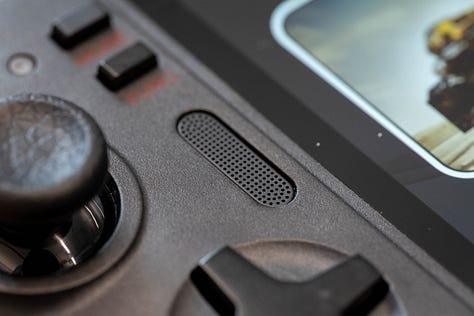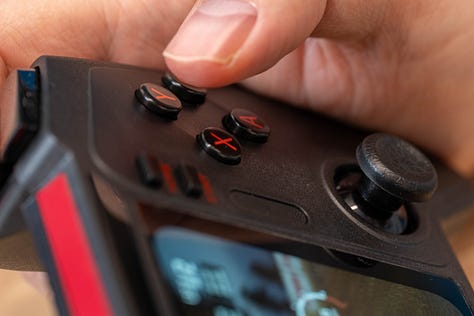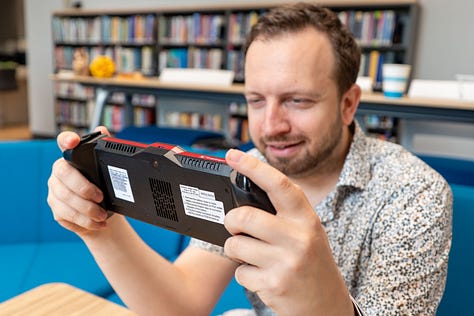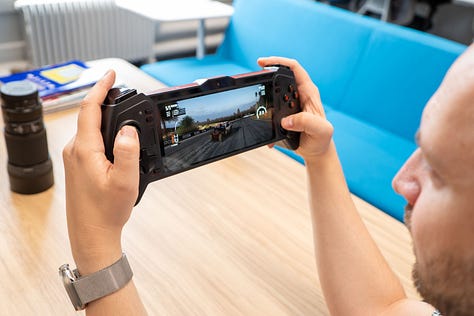Qualcomm Snapdragon G3x Gen 2: one possible future for handheld gaming
Qualcomm's new triple-chipset strategy for handheld gaming is meant to rival AMD
➡️ The Shortcut Skinny
⚙️ Qualcomm’s next-generation chipset for future gaming handhelds
📈 2x GPU performance, 30% faster vs its Gen 1 chip in the Razer Edge
🥽 FullHD+ screen at 144Hz and supports AR glasses (which I tested)
🤼 Could rival AMD’s Ryzen Z1 with better performance vs battery balance
👨👨👦👦 It’s a family: G2 Gen 1 & G1 Gen 1 tipped for devices as low as $199
There’s a lot of new handheld gaming devices out in 2023 – we’ve tested the Steam Deck, Asus ROG Ally and Razer Edge 5G, we just wrote about the Sony PlayStation Portal news today and we at least know the Lenovo Legion Go is on the way.
Qualcomm wants there to be even more, and its new Snapdragon G3x Gen 2 is vying to become the chipset that powers next-generation gaming handheld devices. To pull this off, it’s touting a 2x faster GPU and 30% faster CPU than the first-generation Snapdragon G3x, which was at the heart of the Razer Edge 5G unveiled at CES 2023.
I got a chance to test a reference device that’s powered by the Snapdragon G3x Gen 2. The result? A fairly small and light gaming handheld that combines ray-tracking graphics, play-anywhere portability, fast game switching and support for AR glasses.
It combines ray-tracking graphics, play-anywhere portability, fast game switching and support for AR glasses.
Snapdragon G3x Gen 2 vs its competitors
The Snapdragon G3x Gen 2 reference device immediately reminded me of the leaked (but unconfirmed) Lenovo Legion Go handheld, which is also said to support a pair of AR glasses. But the latest news points to Lenovo using an AMD processor instead.
Here are the official specs from Qualcomm’s G3x Gen 2, which manufacturers may or may alert in their final products:
📺 Screen: Full HD+
🏃♂️ Refresh rate: 144Hz
📸 Camera: Front and Back (for live streaming and AR)
⚙️ Chipset: Qualcomm Snapdragon G3x Gen 2 (duh)
⚙️ GPU: Adreno A32 GPU
⚙️ CPU: Kryo CPU (8 cores)
📶 Connectivity: 5G sub6 and mmWave, WiFi 7, Bluetooth 5.3
🔌 Ports: USB-C
📳 Haptics: Yes (stereo haptics)
It’ll be interesting to see if these specs from Qualcomm’s and ARM-based chipset on yet-to-be-announced Android devices can rival the likes of the AMD Ryzen Z1 and Z1 Extreme that’s being used inside Windows 11-based devices like the Asus ROG Ally and, presumably, the Lenovo Legion Go.
I’m also curious to see if manufacturers that utilize Qualcomm’s chipset are able to go beyond the Android ecosystem – whether it’s Windows or another platform – and increase game compatibility. For now, this chip supports 5G, WiFi 7 and cloud gaming, meaning you can play games on the go through Xbox Game Pass Ultimate, GeForce Now and Steam Link as well as Android.
How Qualcomm could win with the G3x Gen 2
First, sheer horsepower won’t determine the future gaming handheld devices (although that’s a nice perk). Qualcomm may be able to win where the ROG Ally currently gives up, according to our testing: battery life and thermals. An ARM-based chipset solution to modern handheld gaming could provide a better performance vs battery balance compared to a chip based on x86 architecture.









I mean, this exactly where Qualcomm won on mobile vs Intel (which was more suited for powering powerful desktop PCs) a decade ago. Now the Snapdragon 8 Gen 2 rules almost all of this year’s flagship Android smartphones: the Galaxy S23 Ultra, Z Fold 5, Z Flip 5 and OnePlus 11 to name a few that we’ve reviewed. Only the Google Pixel 7a, Pixel Fold, Pixel 7 and 7 Pro use Google’s hamstrung Tensor G2 chipset.
Second, the Snapdragon G3x Gen 2 is just one part of Qualcomm’s triple-chipset strategy that’s aimed at handhelds at varying speeds and price points. Timed with Gamescom, Qualcomm also introduced the Snapdragon G1 Gen 1 and the G2 Gen 1. which are a little less flashy than the G3x Gen 2, which serve a purpose.
The Snapdragon G1 Gen 1 is targeting devices that appeal to gamers who want an affordable portable second screen around the house. Cue the Sony Remote Play-ready PlayStation Portal priced at $199 with this exact functionality (I wouldn’t be shocked if Qualcomm wasn’t involved in the specs).
The Snapdragon G2 Gen 1 falls somewhere in the middle with higher-end specs, but not all of the bells and whistles of the G3x Gen 2 like WiFi 7 and processing power.
G3x Gen 2 reference device play test
I got a chance to test drive Qualcomm’s reference device that was powered by the Snapdragon G3x Gen 2, and I was impressed with its speed and size. It’s lighter and more compact than any of the PC gaming handhelds I’ve tested. This was thanks to the fact that the body of the device is made of carbon fiber.
The 6.8-inch Full HD+ AMOLED screen running at 144Hz made the games look good – for Android. That’s to say that the best-looking game I played was Wreckfest, but it’s still an Android game and hardly required the active cooling. I’m eager to see more games that push the Snapdragon G3x Gen 2 beyond what Fortnite and PUBG can do.
The other thing that caught my eye – or both eyes – is the fact that the G3x Gen 2 reference device supports for AR glasses. I feel as if augmented reality and handheld gaming are a natural fit (I predicted Nintendo Switch 2 could rule this market in my tech predictions earlier this year). I love the idea of being able to play AR games when I want to, but having a portable handheld when I tire of looking at a projection.
The implementation of AR glasses worked well as a second screen, but, again, it’s up to developers to flesh out the software to support this cutting-edge hardware – I’d like to see it become more than just a second screen projection, especially when the Apple Vision Pro price is $3,499 and we need alternatives.
Overall, the Qualcomm Snapdragon G3x Gen 2 chip announcement is good news for mobile gamers who benefit from a crowded field. We’re due to have more options than ever in a category where the Nintendo had been unstoppable – from the Game Boy in 1989 to the Nintendo Switch OLED today. Without a Nintendo Switch 2 to keep up with today’s technology, AMD and Qualcomm are pushing PC-based devices to the next level, and The Shortcut will help you decide which to buy in 2023.






